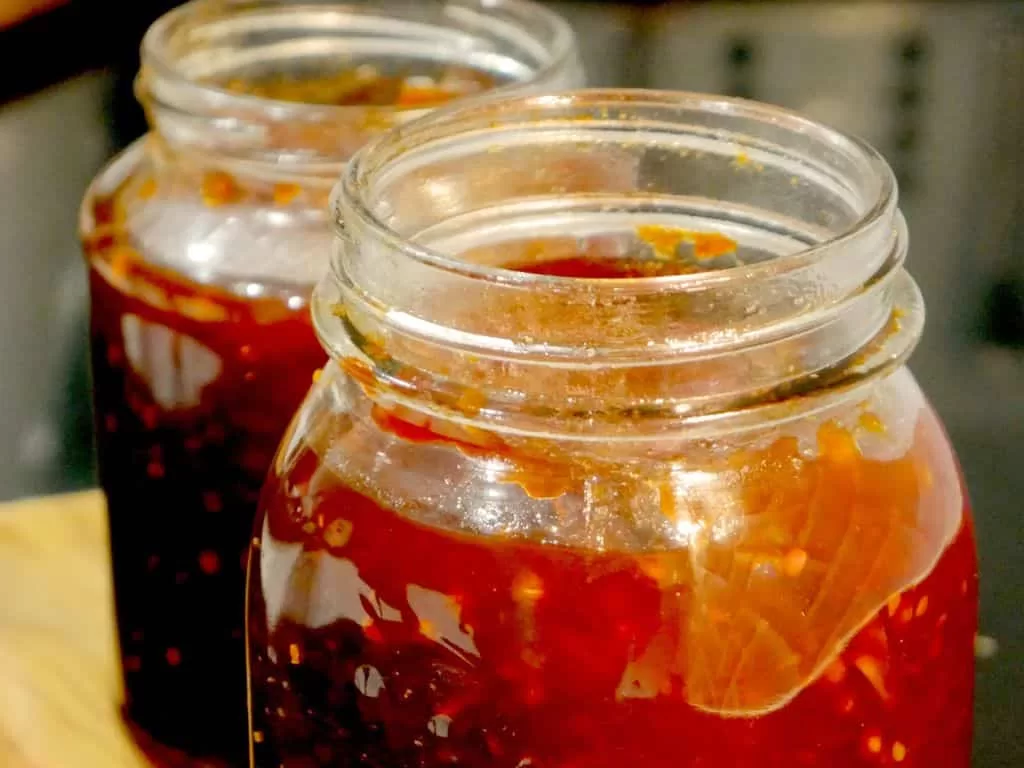The texture of food is important for the look and feel of food, and also for digestion. Thickening and stabilising agents are gums that work with emulsifiers to maintain the texture of food, and create texture in water-based products that would otherwise be runny.
Ingredients such as flour, cornflour and arrowroot have been used for thickening sauces for centuries. In jam, pectin is used to thicken the fruit juices. Pectin is naturally present in fruit, but many fruits don’t contain enough to make the jam set so extra is added.
Natural sources predominate – many thickeners are derived from plants and seaweeds. Others are made by the chemical modification of natural cellulose, and some, such as xanthan gum, are even made by fermentation.
Thickeners and stabilisers tend to be both odourless and tasteless. The gums are polysaccharides – polymers made up of sugar molecules. The majority of these polysaccharides have few or no calories, but many function as fibre in the digestive system. This eases bowel function, and some are used as bulk laxatives.
Most of these gums can form gels at room temperature, and (rather like non-drip paint) they lose their thickness when they are stirred. This makes mixing easier during the production process as they become runny, and then when the mixing stops, they thicken up again.
Some of the most important thickeners and stabilisers are:
Agars (E406) are partly sulfated polysaccharides that were first discovered in Japan in the 17th century which are extracted from two different species of red algae. They have a very high gel strength, and when dissolved in water the gelation process is reversible at 85°C. They are used in jellies, bakery products, sauces, fillings and meat products.
Alginates (E400-404) are salts of alginic acid, a viscous gum formed by the cell walls of brown algae. Food uses include thickening fruit drinks, soups and sauces, and as a gelling agent in jellies and bakery fillings. They are also an important component of several indigestion remedies.
Carrageenans (E407) are sulfated polysaccharides extracted from several species of red seaweed. They are used to thicken dairy products such as ice cream and milk shakes and water-based jellies. They are also components of various processed meat products.
Gum Arabic (E414) is made from the sap of the acacia tree and is a mixture of saccharides and glycoproteins (proteins with attached sugar molecules). Commercially, most is extracted from trees in countries south of the Sahara desert in Africa, and the biggest producers are Chad, Nigeria and Sudan. Food uses include hard jelly sweets and soft drinks.
Guar gum (E412) is extracted from guar beans, which predominantly grow in India. It is a type of water-soluble polysaccharide called a galactomannan, where the polymer chain is made up of galactose sugar units, with mannose sugars attached to it. Uses include baked goods and bakery fillings, thickening dairy products like yoghurt and milk, and as a stabiliser in sauces and dressings. It is also used in meat products.
Locust bean gum (E410), also known as carob bean gum, is (like guar gum) a galactomannan polysaccharide, and is extracted from the seeds of the carob tree. It is water soluble, and is used as a thickener and stabiliser in a variety of products, including sauces, salad dressings, fruit fillings and ice creams.
Pectin (E440) is a gelling agent that is usually extracted from dried citrus peel or the solids that remain when the juice is pressed from apples. It is a polysaccharide made by plant cell walls, and as well as being used to help jams and jellies to set, it is used as a stabiliser in milk drinks and fruit juices.
Sodium carboxymethyl cellulose (E466), or sodium CMC, is a water-soluble semi-synthetic thickener, made by reacting cellulose with an acetic acid derivative. It is used in a variety of products such as breads and cakes, ice creams, and milk and fruit drinks.
Starch (E1401–1451), in its various forms, is one of the most common thickeners in food products. These polysaccharides are isolated from a number of different crops, including wheat, corn, rice, potatoes and cassava. Numerous starch derivatives are also available where the properties have been chemically modified. Unlike many other gums, they are not water-soluble, but the molecules do enter their lattice-like structures, and so they thicken up when mixed with water. Many different types of foods contain starch ingredients, from sauces and pie fillings to sweets and puddings.
Xanthan gum (E415) is made by the fermentation of glucose or sucrose with the microorganism Xanthomonas campestris. It is commonly found in sauces and salad dressings, where it acts as a stabiliser and helps prevent the emulsion from separating.

